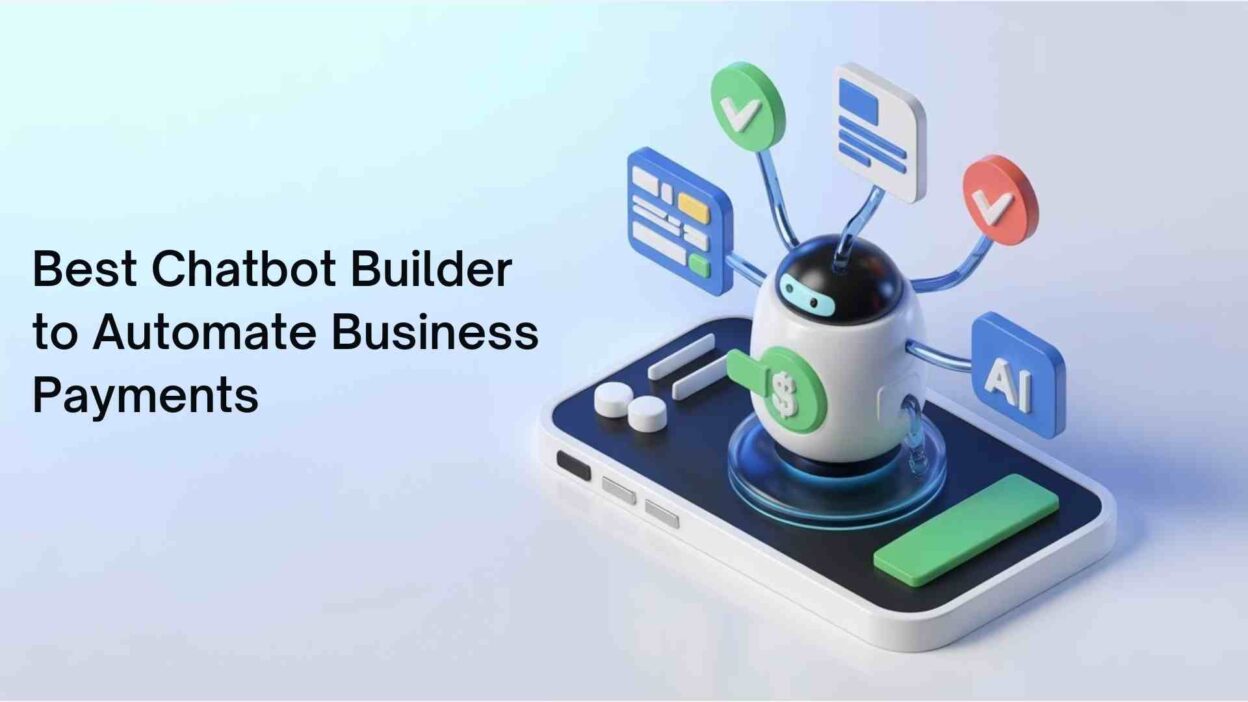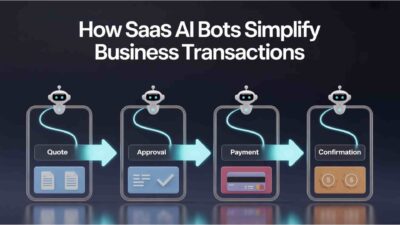TL;DR Running a business in 2025 demands speed. Your customers expect instant responses. They want quick payment processing. Manual handling of transactions slows everything down. A chatbot can change how you collect payments. The right platform makes automation simple.
Table of Contents
Finding the best chatbot builder for business transactions requires careful evaluation. You need a solution that handles payments securely. Your system must integrate with existing tools. The platform should reduce manual work while improving customer experience.
This guide explores top chatbot builders designed for payment automation. We’ll examine features that matter most. You’ll discover which platforms deliver real value. Let’s find the perfect solution for your business needs.
Why Businesses Need Chatbot Builders for Payment Automation
The Payment Processing Challenge
Traditional payment methods create bottlenecks. Customers fill out lengthy forms. They wait for invoice emails. Payment links get lost in inboxes. Your team spends hours chasing payments.
Manual processing increases error rates. Staff members copy payment details incorrectly. Reconciliation takes days instead of minutes. Cash flow suffers from delayed collections. Your business loses money waiting for payments to clear.
How Chatbots Solve Payment Problems
Chatbots streamline the entire payment journey. Customers make purchases through simple conversations. The bot requests payment at the right moment. Transactions complete in seconds rather than days.
Automation reduces your operational costs significantly. One chatbot handles hundreds of payment requests daily. Your team focuses on higher-value activities. Customer satisfaction improves with faster processing. The best chatbot builder for business transactions eliminates payment friction entirely.
Real Business Impact
Companies using payment chatbots see measurable results. Cart abandonment rates drop by up to 60%. Payment collection time decreases from days to minutes. Customer support tickets related to payments fall dramatically.
Your business can operate around the clock. The chatbot processes payments at 3 AM just as efficiently as noon. International customers pay in their preferred currency. Transaction data flows directly into your accounting system. Revenue recognition becomes instantaneous rather than delayed.
Essential Features in a Chatbot Builder for Business Transactions
Secure Payment Gateway Integration
Security cannot be compromised when handling financial transactions. Your chatbot builder must support PCI DSS compliance standards. Encryption protects sensitive payment information throughout the process. Tokenization keeps card details safe from potential breaches.
The best chatbot builder for business transactions offers multiple payment gateway options. Stripe integration provides flexibility for global transactions. PayPal support reaches customers who prefer familiar platforms. Square connectivity works well for retail-focused businesses. Direct bank transfer options serve B2B payment scenarios perfectly.
Multi-Channel Deployment Capabilities
Your customers use different communication platforms daily. Some prefer website chat interfaces. Others spend time on Facebook Messenger. Many businesses rely on WhatsApp for customer communication. SMS remains powerful for reaching older demographics.
A robust chatbot builder deploys across all these channels simultaneously. You build the payment flow once. The system adapts automatically to each platform. Customers complete transactions on their preferred channel. Your business maintains consistent payment experience everywhere.
Intelligent Conversation Design
Payment collection requires natural conversational flow. The chatbot must understand customer intent accurately. Context awareness prevents frustrating repetition during transactions. Natural language processing handles variations in customer responses.
Smart conversation builders include pre-built payment templates. You customize these templates for your specific business needs. The bot guides customers through verification steps smoothly. Error handling explains problems clearly when payments fail. Retry logic gives customers easy options to fix issues.
Real-Time Analytics and Reporting
Data-driven decisions require comprehensive analytics. Your chatbot builder should track payment conversion rates. You need visibility into drop-off points during transactions. Performance metrics reveal which conversation flows work best.
Dashboard displays show daily transaction volumes clearly. Revenue reports break down payments by channel and product. Failed transaction analysis helps you identify system improvements. Customer behavior insights guide optimization efforts effectively.
Automated Payment Reminders
Following up on unpaid invoices wastes valuable time. Automated reminder systems handle this task efficiently. The chatbot sends payment requests at scheduled intervals. Personalized messages maintain professional tone throughout collections.
Smart scheduling considers customer time zones automatically. Reminder frequency increases gradually for overdue payments. The system stops notifications once payment completes. Integration with your CRM tracks all reminder activities thoroughly.
Top Chatbot Builders for Automating Business Payments
Intercom for Payment Collection
Intercom combines customer communication with transaction capabilities. The platform excels at relationship-driven sales processes. Payment links integrate seamlessly into conversation threads. Customers complete purchases without leaving the chat window.
The builder offers extensive customization for payment flows. You can segment customers based on purchase history. Targeted messages increase conversion rates for specific products. API access enables deep integration with custom systems.
Pricing starts at reasonable levels for small businesses. Enterprise plans include advanced automation features. The platform scales as your transaction volume grows. Support quality remains consistently high across all plan levels.
ManyChat for E-Commerce Transactions
ManyChat dominates the social media chatbot space effectively. Facebook and Instagram integrations work flawlessly out of the box. Payment processing through native Meta solutions simplifies setup. The visual builder makes complex flows accessible to non-technical users.
Pre-built templates accelerate deployment for common scenarios. Cart abandonment recovery flows come ready to customize. Order tracking integration keeps customers informed automatically. Broadcast features promote new products to existing customers powerfully.
The free tier supports basic payment functionality adequately. Pro plans unlock advanced segmentation and analytics. Growth plans add priority support and higher message limits. The best chatbot builder for business transactions should match ManyChat’s ease of use.
Tidio for Small Business Payments
Tidio focuses on small business needs specifically. The platform combines live chat with chatbot automation smartly. Payment requests can come from either bots or human agents. Handoff between automation and humans happens smoothly when needed.
Setup takes minutes rather than hours or days. Payment gateway connections require just a few clicks. Templates cover common small business transaction scenarios. Mobile apps let you monitor payments on the go.
Pricing remains competitive for businesses with limited budgets. Features scale appropriately as your business grows larger. Customer support responds quickly to setup questions. The learning curve stays minimal throughout the onboarding process.
Chatfuel for Service-Based Businesses
Chatfuel specializes in appointment-based service payments. The builder handles booking confirmations and deposit collection. Reminder sequences reduce no-show rates significantly. Payment processing happens before appointment dates automatically.
Integration with scheduling tools creates seamless workflows. Customers book appointments and pay in one conversation. Confirmation messages include all relevant appointment details. Rescheduling options maintain customer flexibility while protecting payments.
The platform supports recurring payment scenarios well. Subscription services find the automation particularly valuable. Membership renewals happen without manual intervention needed. Payment failure handling includes smart retry logic built in.
Landbot for Custom Payment Experiences
Landbot offers exceptional design flexibility for payment flows. The drag-and-drop interface creates beautiful conversation experiences. Visual branching makes complex payment logic understandable quickly. Custom CSS allows complete brand alignment throughout conversations.
Web-based deployment creates embedded payment experiences seamlessly. No-code integration connects to major payment processors easily. Conditional logic personalizes payment options based on customer data. A/B testing features optimize conversion rates over time.
Pricing reflects the platform’s premium positioning accurately. The investment pays off for businesses requiring distinctive experiences. White-label options remove Landbot branding for enterprise clients. API access enables advanced customization when needed most.
Comparing Chatbot Builders: Which Best Suits Your Business?
For E-Commerce Stores
Online retailers need specific payment automation capabilities. Cart recovery represents the highest ROI opportunity immediately. Product recommendation engines increase average order values significantly. Order tracking reduces support inquiries about shipment status.
The best chatbot builder for business transactions in e-commerce integrates with Shopify seamlessly. WooCommerce compatibility matters for WordPress-based stores. Inventory synchronization prevents selling out-of-stock items accidentally. Multi-currency support serves international customer bases effectively.
ManyChat or Chatfuel work exceptionally well for social commerce. Their Meta platform integration feels completely native. Impulse purchases happen directly within Instagram or Facebook. Payment processing completes without redirecting to external websites.
For Service Professionals
Consultants, coaches, and freelancers have unique payment needs. Appointment scheduling paired with deposit collection prevents cancellations. Package purchases for multiple sessions simplify pricing conversations. Invoicing automation saves hours of administrative work weekly.
Calendar integration synchronizes availability across all platforms automatically. Payment confirmations trigger calendar blocks in real time. Reminder sequences include payment links for outstanding balances. Client portals accessed through chat provide service history clearly.
Tidio or Landbot serve individual practitioners particularly well. Setup complexity remains low while functionality stays high. Pricing scales appropriately for solo business operations. Customer support helps solve issues specific to service businesses.
For B2B Companies
Business-to-business transactions involve longer sales cycles typically. Payment terms like Net 30 require different automation approaches. Multiple stakeholder approvals complicate the payment process substantially. Purchase orders need proper documentation and tracking systems.
Enterprise chatbot builders must integrate with existing ERP systems. Approval workflows route payment requests to appropriate managers. Documentation capture stores necessary paperwork for compliance purposes. Reporting provides visibility into accounts receivable aging effectively.
Intercom excels in B2B environments with complex needs. Customization capabilities match enterprise requirements precisely. Security features meet strict compliance standards required by corporations. Support quality matches the premium pricing structure appropriately.
For Subscription Businesses
Recurring revenue models demand specialized payment automation features. Initial subscription setup must be frictionless and fast. Renewal processing happens automatically without customer intervention needed. Failed payment recovery protects against involuntary churn effectively.
Dunning management prevents revenue loss from expired cards. Smart retry logic maximizes successful payment recovery rates. Customer communication about payment issues maintains positive relationships. Upgrade and downgrade flows handle plan changes smoothly.
The best chatbot builder for business transactions in subscription models includes Chatfuel. Recurring billing integrations work reliably across billing cycles. Customer retention features reduce voluntary cancellation rates. Analytics show subscription health metrics at a glance.
Implementation: Building Your First Payment Chatbot
Planning Your Payment Flow
Start by mapping your current payment process completely. Identify every step customers take from interest to payment. Note where friction occurs most frequently in the journey. Document common questions customers ask during transactions.
Define your chatbot’s personality and tone carefully. Professional businesses require formal communication styles. Consumer brands might adopt friendlier, casual tones. Consistency across all interactions builds customer trust quickly.
Outline the conversation paths for different scenarios thoroughly. Happy path flows when everything works perfectly. Error recovery paths when payments fail or cards decline. Escalation procedures when customers need human assistance urgently.
Connecting Payment Gateways
Choose payment processors that serve your customer base effectively. Stripe works excellently for businesses with international customers. Square suits retail operations with physical presence well. PayPal reaches customers uncomfortable sharing card details directly.
Follow the chatbot builder’s integration documentation carefully during setup. Test mode prevents real charges during development phases. Verify webhook configurations for payment confirmation callbacks. Ensure error messages display clearly when connections fail.
Security settings require particular attention during configuration. Enable 3D Secure authentication for fraud prevention. Set appropriate payment amount limits for automated processing. Configure decline handling to prompt customers for alternative methods.
Testing Your Payment Chatbot
Never deploy payment systems without thorough testing first. Use test credit card numbers provided by payment processors. Verify successful transaction flows from start to finish. Test failed payment scenarios to confirm proper error handling.
Check all payment confirmation messages for accuracy completely. Verify that transaction data reaches your backend systems correctly. Test refund processes to ensure money returns to customers properly. Mobile testing catches issues that desktop testing might miss.
Invite beta users to complete real transactions carefully. Gather feedback about confusing steps or unclear instructions. Monitor transaction success rates closely during initial deployment. Make adjustments quickly based on real user behavior patterns.
Optimizing Conversion Rates
Analytics reveal exactly where customers abandon payment flows. High drop-off at specific steps indicates problems needing attention. A/B test different message variations to improve engagement. Visual elements like emojis can increase click-through rates significantly.
Payment timing affects conversion rates more than most realize. Requesting payment too early scares customers away quickly. Waiting too long gives customers time to reconsider purchases. Find the perfect moment when purchase intent peaks naturally.
Trust signals reduce hesitation during payment collection phases. Security badges remind customers their data stays protected. Money-back guarantees reduce perceived risk of purchase decisions. Customer testimonials build confidence in your products or services.
Security and Compliance Considerations
Protecting Customer Payment Data
Payment Card Industry Data Security Standard compliance isn’t optional. Your chatbot must never store raw credit card numbers. Tokenization keeps sensitive data secure from potential breaches. End-to-end encryption protects information during transmission always.
The best chatbot builder for business transactions handles PCI compliance automatically. Payment processors manage sensitive data on your behalf. Your chatbot only stores transaction references and confirmation codes. This approach minimizes your security liability significantly.
Regular security audits identify potential vulnerabilities proactively. Penetration testing reveals weaknesses before hackers discover them. Keep all software updated with latest security patches. Employee training prevents social engineering attacks on your systems.
Meeting Regulatory Requirements
Different industries face varying compliance requirements strictly. Healthcare businesses must comply with HIPAA regulations carefully. Financial services follow stringent banking regulations thoroughly. E-commerce operations need to understand consumer protection laws clearly.
Data privacy regulations like GDPR affect European customer transactions. California’s CCPA impacts businesses serving California residents specifically. Understand your obligations before processing payments from customers. Non-compliance results in substantial fines and legal problems.
Payment terms must be clearly communicated before collection occurs. Refund policies need explicit statements customers can access easily. Subscription terms require clear explanation of billing frequency. Transparency builds trust while meeting legal obligations simultaneously.
Fraud Prevention Strategies
Automated payment systems attract fraudulent activity unfortunately but predictably. Velocity checks limit transaction numbers within specific timeframes. Amount limits prevent unusually large fraudulent transactions from succeeding. Geographic restrictions block payments from high-risk countries entirely.
Machine learning models identify suspicious transaction patterns accurately. Behavioral analysis detects bots attempting automated payment fraud. Two-factor authentication adds security layers for high-value transactions. Manual review queues flag questionable transactions for human investigation.
Chargeback management protects your business from revenue loss. Clear transaction descriptions reduce customer confusion and disputes. Prompt customer service resolution prevents escalation to chargebacks. Documentation of delivery proves service provision when disputes arise.
Integration with Business Tools
CRM System Connections
Customer Relationship Management systems store valuable transaction history. Payment data flowing into your CRM creates complete customer profiles. Sales teams access purchase history during customer conversations easily. Marketing segmentation uses transaction data for targeted campaigns effectively.
Popular CRMs like Salesforce integrate with major chatbot builders smoothly. HubSpot connections sync contact data and transaction records automatically. Pipedrive integration helps track deals from conversation to payment. Custom CRM systems connect through API endpoints and webhooks.
Automated data entry eliminates manual record-keeping work completely. Customer information updates across all systems simultaneously after payments. Deal stages advance automatically when payments process successfully. Revenue attribution becomes accurate without manual intervention needed.
Accounting Software Integration
Financial record-keeping requires accurate transaction data immediately. QuickBooks integration creates invoice records and payment entries automatically. Xero connections keep books updated in real time constantly. FreshBooks sync eliminates duplicate data entry for service businesses.
Payment reconciliation happens automatically instead of taking hours monthly. Revenue recognition follows proper accounting principles without manual work. Tax reporting becomes simpler with organized transaction records. Audit trails document every transaction for compliance purposes thoroughly.
The best chatbot builder for business transactions simplifies accounting workflows dramatically. Payment processor fees get recorded as expenses automatically. Customer payment methods are tracked for future reference. Financial reporting generates accurate statements without additional data manipulation.
Marketing Platform Connections
Payment data enhances marketing automation dramatically when connected properly. Customer purchase behavior triggers personalized email campaigns automatically. High-value customers receive VIP treatment and exclusive offers. Cart abandonment sequences target customers who nearly completed purchases.
Email marketing platforms like Mailchimp segment lists by purchase history. Klaviyo creates sophisticated flows based on transaction patterns. ActiveCampaign automation adapts to customer lifetime value calculations. SMS marketing reaches customers on their mobile devices effectively.
Retargeting campaigns become more effective with transaction data insights. Facebook Custom Audiences exclude recent purchasers from acquisition ads. Google Ads remarketing targets visitors who viewed but didn’t purchase. Cross-sell campaigns promote complementary products to existing customers intelligently.
Measuring Success: Key Performance Indicators
Transaction Conversion Metrics
Payment conversion rate measures chatbot effectiveness at collecting payments. Calculate by dividing successful payments by total payment attempts. Industry benchmarks vary but most aim for 70% or higher. Improvements of even 5% dramatically impact overall revenue significantly.
Average transaction value indicates upselling and cross-selling effectiveness. Higher values suggest customers trust your recommendations enough to spend more. Track this metric over time to measure optimization efforts. Segment by customer type to identify high-value audience segments.
Time to payment completion reveals friction in your process. Faster payments indicate smooth, intuitive conversation flows working well. Longer times suggest confusion or technical issues needing resolution. Aim to reduce this metric continuously through ongoing optimization.
Customer Experience Indicators
Customer satisfaction scores measure payment experience quality directly. Post-transaction surveys gather feedback while experiences stay fresh. Net Promoter Scores indicate the likelihood of customer recommendations. High scores validate your chatbot approach while low scores demand investigation.
Support ticket volume related to payments indicates problem areas clearly. Decreased tickets suggest your chatbot handles issues effectively independently. Increased tickets might indicate confusing messaging or technical problems. Monitor ticket content to identify recurring themes requiring attention.
Repeat purchase rate demonstrates customer confidence in your payment process. Customers who paid easily once return more readily. Growing repeat rates validate your automation investment substantially. Declining rates signal potential trust or experience issues.
Operational Efficiency Gains
Staff time saved represents a tangible cost reduction from automation. Calculate hours previously spent on manual payment processing. Multiply by average hourly costs to determine savings achieved. These savings often justify chatbot investment within months rather than years.
Payment processing errors decrease with automated systems compared to manual entry. Track error rates before and after chatbot implementation carefully. Reduced errors means fewer refunds, disputes, and customer complaints. Your business reputation improves alongside operational efficiency gains.
24/7 availability enables payment collection during traditional off-hours effectively. Calculate payments received outside business hours as additional revenue. These transactions might never have occurred without automation capabilities. The best chatbot builder for business transactions never sleeps or takes breaks.
Common Challenges and Solutions
Handling Payment Failures
Declined transactions frustrate customers and cost your business revenue. Clear error messages help customers understand what went wrong. Suggest alternative payment methods when one card fails. Provide easy retry options without restarting the entire conversation.
Failed payment recovery sequences automatically follow up with customers. First reminder goes out within hours of the failure. Subsequent reminders increase urgency while maintaining a respectful tone. Multiple payment method options increase recovery success rates substantially.
Technical issues occasionally prevent payment processing from working properly. Status pages inform customers about known system problems. Fallback options like email invoices maintain business continuity always. Detailed error logging helps technical teams diagnose problems quickly.
Managing Customer Trust Concerns
Some customers hesitate to pay through chatbot interfaces initially. Trust signals reassure them about security and legitimacy. Display security badges prominently during payment collection phases. Include links to your privacy policy and terms clearly.
Social proof builds confidence through customer testimonials and reviews. Show transaction volume or customer counts prominently when appropriate. Money-back guarantees reduce the perceived risk of purchase decisions. Live chat escalation options comfort customers wanting human interaction.
Transparent pricing prevents surprises during checkout processes completely. Display all fees, including taxes, before final payment submission. Itemized receipts show exactly what customers paid for clearly. Confirmation messages arrive immediately after successful transactions complete.
Scaling Payment Volume
Growing transaction numbers can strain chatbot systems eventually without planning. Load testing identifies capacity limits before they cause problems. Cloud-based infrastructure scales automatically with demand increases. Redundancy prevents single points of failure from disrupting payments.
Payment processor limits might restrict transaction volumes or sizes. Discuss volume projections with processors before hitting limits. Enterprise accounts often provide higher limits and better support. Multiple processor accounts provide backup options during outages.
Customer support needs scale alongside transaction volume growth. Chatbot optimization reduces support burden by handling issues automatically. Knowledge base articles help customers solve problems independently often. Support team training ensures quality assistance when escalation becomes necessary.
Future Trends in Payment Chatbot Technology
Artificial Intelligence Advances
Machine learning enables increasingly sophisticated payment conversations naturally. Bots understand context better and provide more relevant responses. Predictive analytics anticipate customer needs before explicit requests occur. Personalization deepens as systems learn individual customer preferences thoroughly.
Natural language processing improvements make conversations feel completely human. Customers forget they’re talking to automated systems increasingly often. Voice interfaces enable payment collection through spoken conversations easily. Multiple language support reaches global audiences without separate bot versions.
The best chatbot builder for business transactions will incorporate these advances automatically. Updates happen seamlessly without requiring complete rebuilds of existing flows. Backward compatibility protects investment in current conversation designs. API improvements enable new capabilities without disrupting working systems.
Cryptocurrency Payment Options
Digital currencies are becoming increasingly mainstream payment methods gradually. Bitcoin and Ethereum acceptance reach more businesses monthly. Stablecoins provide cryptocurrency benefits without volatility concerns significantly. Smart contract integration enables programmatic payment triggering automatically.
Chatbot builders add cryptocurrency wallet integrations to payment options. Customers choosing crypto complete transactions just as easily. Automatic conversion to local currency protects the business from volatility. Transaction fees often come in lower than traditional payment processors.
Regulatory clarity improves as governments establish cryptocurrency frameworks properly. Compliance requirements become clearer and easier to implement. Tax reporting tools mature to handle cryptocurrency transactions correctly. Mainstream adoption accelerates as barriers to entry decrease steadily.
Biometric Authentication
Fingerprint and facial recognition replace password entry increasingly often. Biometric authentication provides security without friction during payments. Voice recognition verifies identity during conversational transactions naturally. Behavioral biometrics detect fraud through typing and interaction patterns.
Payment authentication becomes completely invisible to legitimate customers. Security improves while user experience gets simpler simultaneously. Fraud rates decrease as biometric spoofing becomes more difficult. Privacy concerns get addressed through on-device processing instead of cloud storage.
Chatbot platforms integrate biometric capabilities through device APIs easily. Implementation requires minimal development effort from business owners. Customer adoption grows rapidly as convenience benefits become obvious. The technology becomes standard rather than innovative relatively quickly.
Choosing Your Payment Chatbot Builder: Final Considerations
Budget and Pricing Models
Chatbot builder costs vary dramatically across different platforms currently. Free tiers provide basic functionality for testing purposes. Starter plans range from modest monthly fees to significant investments. Enterprise pricing reflects advanced features and dedicated support teams.
Transaction-based pricing charges per payment processed through the system. Percentage-based fees scale with your revenue volumes proportionally. Fixed monthly costs provide predictable expenses regardless of volume. Hybrid models combine subscription fees with per-transaction charges.
Calculate the total cost of ownership beyond just subscription fees. Implementation costs include setup time and technical integration work. Training expenses get your team comfortable using the platform. Ongoing optimization requires either staff time or consultant fees.
Technical Capabilities Assessment
Evaluate your team’s technical skill level honestly before choosing platforms. No-code builders empower non-technical teams to create sophisticated flows. Low-code options provide flexibility while remaining accessible to most users. Full-code platforms require developer resources but offer unlimited customization.
Integration requirements depend on your existing technology stack completely. API availability enables connections to custom systems and databases. Webhook support allows real-time data synchronization across platforms. Pre-built integrations save development time for common business tools.
The best chatbot builder for business transactions matches your technical capacity perfectly. Overly complex platforms frustrate non-technical teams and delay deployments. Overly simple platforms limit growth as business needs become sophisticated. Find the balance point appropriate for your current and future needs.
Vendor Support and Community
Quality support prevents small issues from becoming business problems. Evaluate response times and support channel availability carefully during selection. Live chat support provides immediate help during critical situations. Email support works for less urgent questions and feature requests.
Documentation quality varies significantly between chatbot platforms, unfortunately. Comprehensive guides accelerate implementation and reduce support dependency. Video tutorials help visual learners understand features more quickly. Community forums connect you with other users solving similar challenges.
Active development roadmaps indicate platform commitment to continuous improvement. Regular feature releases show responsiveness to market needs. User feedback incorporation demonstrates customer-centric development practices. Stagnant platforms risk falling behind competitive alternatives rapidly.
Read More: Best AI Call Escalation Solutions for Growing Businesses
Conclusion

Payment automation transforms how businesses collect money from customers. The right chatbot builder eliminates friction throughout transaction processes. Your team saves countless hours previously spent on manual tasks. Customers enjoy faster, more convenient payment experiences consistently.
Choosing the best chatbot builder for business transactions requires thoughtful evaluation. Consider your specific business model and transaction types carefully. Assess technical capabilities against your team’s skill levels honestly. Evaluate integration needs with existing business systems thoroughly.
Start with clear goals for what you want to achieve. Improved conversion rates justify automation investments quickly. Reduced operational costs provide ongoing savings year after year. Enhanced customer experience builds loyalty that compounds over time.
Test multiple platforms before making final decisions, if possible. Most builders offer trial periods or free tiers for evaluation. Real-world testing reveals strengths and limitations clearly. Customer support quality becomes apparent during implementation phases.
The investment in the best chatbot builder for business transactions pays dividends immediately. Revenue collection accelerates from days to minutes after deployment. Your business operates efficiently around the clock automatically. Customer satisfaction improves as payment friction disappears completely.
Payment automation represents the future of business transactions undeniably. Early adopters gain competitive advantages over slower-moving competitors. Technology continues to improve, making implementation easier over time. The question isn’t whether to automate but which platform serves you best.
The best chatbot builder for business transactions waits for your decision. Choose wisely based on your unique business requirements. Implement thoroughly with proper testing and optimization planned. Monitor results and adjust strategies based on performance data.
Success comes from matching the right technology to specific needs. Payment chatbots deliver measurable results when implemented properly. Your business deserves the efficiency and customer experience improvements available. Start building your payment automation solution today for tomorrow’s success.






[…] Read More:-Best Chatbot Builder to Automate Business Payments […]